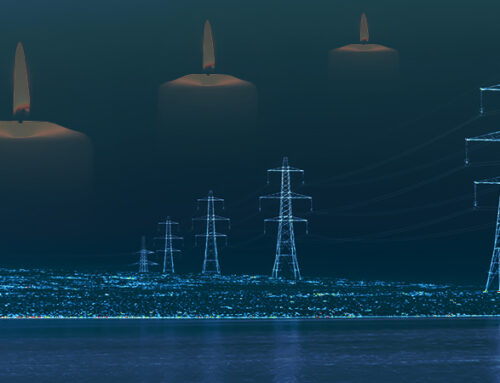The first auction for enhanced frequency response (“EFR”) in the UK closed at the end of August, with just over 200 MW being secured by National Grid under 4-year contracts, at unexpectedly low prices. All of the winning sites were as yet un-built battery storage projects, and there were a significant number of similar projects which failed to secure contracts, indicating the degree of interest in development of the battery storage industry. However the low pricing and short contract tenors poses some threats.
What is EFR for?
Historically, electricity systems were comprised of large generators whose turbines rotate in synchrony with the grid (hence, synchronous generation). The grid frequency is directly related to the number of revolutions each turbine makes in a minute (generators on a 50 Hz system rotate at 3000 RPM, except for nuclear-powered turbines which rotate at half the speed). If demand exceeds supply, then the system frequency falls, and vice versa, and unless corrected by addition or removal of generation, failsafes will trigger to avoid mechanical damage to systems, which may result in supply disruption.
Wind and solar power do not provide mechanical inertia to the electricity system, and their intermittency makes frequency control even more challenging. As a result, system operators are expanding the suite of grid management tools, and the recent EFR auction by National Grid is part of this process.
EFR is defined by National Grid as being a service that achieves 100% active power output at 1 second (or less) of registering a frequency deviation. Other frequency response services include Primary and High which have timescales of 10 seconds, and Secondary which has timescales of 30 seconds.
Batteries the big winners in the first EFR auction
In June, National Grid announced an auction for the procurement of 200 MW of EFR services, the results of which were announced in late August. These services focus on pre-fault control, ie frequency management within normal operational bands. Within this arena, National Grid has established two services: Service 1 which has a wider frequency insensitive band of ± 0.05 Hz (ie the range of frequencies either side of 50 Hz at which output does not vary), and Service 2 with a narrower ± 0.015 Hz band. While Service 1 is efficient in times of low inertia, for example in the summer, a narrower band is needed to manage high inertia scenarios, hence Service 2 has year-round value.

A total of 1.4 GW of viable projects participated in the auction, with 8 battery storage projects securing 4-year contracts at prices between £7.00 and £11.97 / MW/h. The overall cost was £65.95 million, which National Grid says will save £200 million compared with other sources of frequency control. The pricing is significantly cheaper than the average availability payment for Firm Frequency Response which was £35.49 per MWh according to the Energy Storage Operators Forum.

The auction was designed to be technology neutral, although most participants were battery projects, since batteries are capable of fast discharge response times. Of the 64 sites that participated in the auction, 61 were battery projects, while 2 were turndown DSR sites and 1 was a thermal generator, with only battery projects being successful.
Questions have been asked about the economics of these projects, as the auction cleared significantly below the expected price levels, and the contract tenors of 4-years are short for supporting new-build projects, although longer than other ancillary services contracts provided by National Grid.
Almost 70% of respondents in a recent survey of battery developers by Smartest Energy stated that provision of grid services was the main revenue stream they were pursuing, so the importance of achieving the right levels of returns are very important.
Making the economics work
The high level of interest in the auction supports the view that the industry sees the changing shape of the energy system providing opportunities for balancing services, however the low prices are causing some concern.
BEIS’ head of energy storage, Rachel Cooper, said in September that the prices were “lower perhaps than we were expecting to see” and added it remains to be seen “whether they are profitable or not.” She added that this was a result of companies wanting to be involved in the service at “whatever cost” to gain a “foothold for an expansion of that service”.
The Smartest Energy survey indicates that most developers see a payback period of under 10 years, but typically longer than the 4 year contracts on offer from National Grid, however about 16% of respondents felt payback periods would exceed 10 years. Under-bidding in order to win market share or secure a perceived first mover advantage is a risky strategy and the nascent industry would not benefit from early failures if the economics don’t work at these levels.
“Battery storage presents a significant opportunity for the UK energy sector and stakeholders across the industry are excited about the potential…. However, there are clearly many uncertainties undermining the business case for a lot of these projects.”
Making the commercial case for battery storage, Smartest Energy
Based on this first EFR auction battery developers will need to secure multiple revenue streams in order to make projects viable. In an environment of high competition and low prices for grid stabilisation services, co-location with renewable generators in order to provide balancing services to the generators, will be increasingly attractive. This would enable generators to avoid curtailment losses by charging in periods of over-production, and to minimise imbalance costs by discharging in periods of under-production. It is also likely that they will seek to participate in provision of other balancing services to National Grid.
Other developments could be seen as distribution network operators evolve into distribution system operators. BEIS has indicated it would like to see procurement of frequency control by parties other than National Grid to help create more competition and more opportunities for storage providers. The desire to see other parties procuring balancing and ancillary services is echoed by many in the industry who see the need to deal with a monopolistic provider as potentially inhibiting the growth of the sector.
This is starting to be a theme, as seen in my previous post on DSR. Decarbonisation is fundamentally changing the way in which electricity is generated and delivered….perhaps it is time to revisit the question of market structure and the role of the system operator to ensure that an affordable low carbon system is delivered.






Leave A Comment